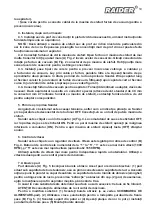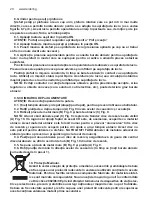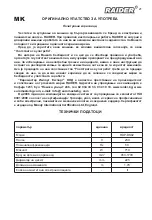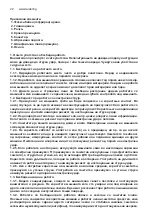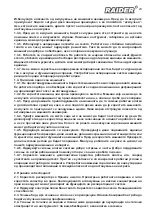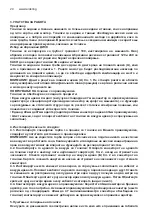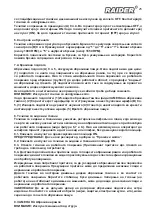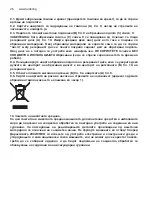
14
www.raider.bg
supplied with the vacuum cleaner.
CAUTION: Failure to use a dust bag rated for drywall dust will increase the level of airborne
dust particles in the work area. Continued and prolonged exposure to high concentrations of
airborne dust may affect the respiratory system function.
4.2. Connect the vacuum hose to the Drywall Sander: Open the Drywall Sander’s hose
connector by turning the large nut (A) Fig. 2, counterclockwise a couple of turns. Push the
vacuum hose swivel connector (B) Fig. 2 into the Drywall Sander connector and seat firmly.
Turn the large nut clockwise to tighten connector.
4.3. Install the six “hook & loop” type straps, to prevent tangling of the Sander cord and the
vacuum hose. Lay the cord and the vacuum hose out parallel to each other. Space the straps
at approximately two foot intervals, beginning two feet from the Drywall Sander. Wrap the long
end of each strap around the vacuum hose and close. Then wrap the short end of each strap
around the cord and close (see Fig. 3).
4.4. Connect the vacuum hose to your vacuum cleaner: Use the 40mm to 47mm adapter
if necessary. If your vacuum cleaner requires a special connector (something other than the
standard 40mm to 47mm connectors supplied with the Drywall Sander), contact your vacuum
cleaner supplier for the proper adapter.
5. TO START AND STOP DRYWALL SANDER
Make sure power circuit voltage is the same as shown on the specification plate on the
Sander, and that the Sander switch is OFF. Connect Sander to power circuit.
The Drywall Sander is equipped with a “rocker” type switch (A) Fig. 4. The top end of the
switch button is labeled OFF, and the bottom end of the button is labeled ON. To start the
Sander: depress the bottom (ON) end of the switch button. To stop the Sander: depress the
top (OFF) end of the switch button.
6. SPEED CONTROL
The Drywall Sander is equipped with a variable speed control. The speed is adjusted
by turning the control knob (B) Fig. 4. The control knob is numbered “1” through “5” with
“1” being the slowest speed (approximately 1000 RPM) and “5” being the fastest speed
(approximately 1650 RPM).
Use the higher speed settings for fast stock removal. Use the lower speed setting to reduce
removal rate for more precise control.
7. BRUSH-TYPE SKIRT
A brush-type skirt (A) Fig. 5, surrounds the abrasive pad. This skirt serves two purposes:
(1) The skirt extends below the surface of the abrasive pad so that it contacts the work surface
first. This positions the sanding head parallel to the work surface before the abrasive contacts
the work, preventing the abrasive from “gouging” the work. (2) The skirt also helps contain the
drywall dust until the vacuum cleaner pulls it away.
If the skirt is damaged, or if it becomes worn excessively: it should be replaced. Replacement
skirts are available from any FLEX Service Center (see list in back of this manual).
CAUTION: DISCONNECT SANDER FROM POWER CIRCUIT.
To replace skirt: (1) Remove abrasive pad (see ABRASIVE PAD REPLACEMENT). (2) Use
phillips screwdriver to remove the six retaining screws (B) Fig. 5. (3) Lift the skirt out of
housing. (4) Position new skirt to housing and install the six retaining screws. (5) Replace the
abrasive pad.
8. SANDING DRYWALL
The Drywall Sander has a unique articulating sanding head: the head can swivel in multiple
directions, allowing the abrasive pad to conform to the work surface (see Figs. 6,7, and 8).
This enables the operator to sand the top, middle and bottom of a wall or ceiling joint without
changing his position.
Summary of Contents for RDP-DS02
Page 3: ...3 ...
Page 4: ...4 www raider bg ...
Page 48: ...48 www raider bg Exploded drawing of Drywall Sander RDP DS02 ...
Page 49: ...49 Spare Parts List of Drywall Sander RDP DS02 ...
Page 60: ...60 www raider bg ...
Page 65: ...65 ...
Page 67: ...67 ...



















